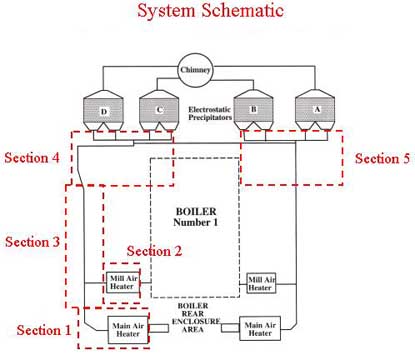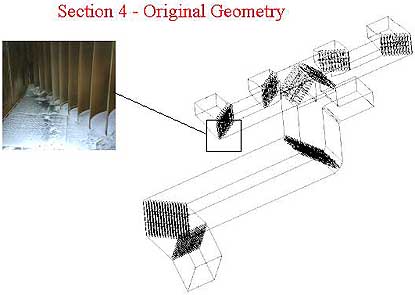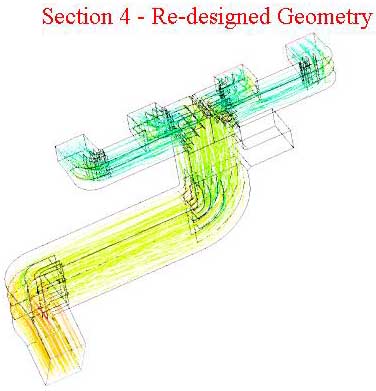Scottish Power Nets Results from Flue Gas Ducting Upgrade
Using a computer simulation, Scottish Power and CFD consultants at Fluent Europe (Sheffield, United Kingdom) recently conducted a ducting upgrade that increased the power output at Scottish Power's Longannet coal-fired power station in Central Scotland by 10% and reduced maintenance. The simulation—using computational fluid dynamics (CFD)—helped engineers understand where excessive pressure drops occurred in the original ducting.
After evaluating several potential alternatives, Scottish Power carried out the CFD-inspired retrofit. And, the success of the design change convinced management to retrofit identical runs of ducting on all the boilers on the Longannet site.
Longannet is one of the largest plants operated by Scottish Power. Each of its boilers generates about 600 MW of power. The "dirty" flue gases exiting the boilers pass along ducting encased by insulated cladding. These ducts are as much as 20ft high by 12ft wide in places. They convey particle-laden gases into electrostatic precipitator (ESP) units where the ESPs remove fine, silica-based fly ash from the warm gas before it exits the plant through a central chimney.

Just prior to Longannet's summer shutdown of its #1 boiler, the plant engineers asked the Fluent Europe consultants to propose a redesign of the existing ducting with the aim of improving performance. In parallel with the CFD work, Scottish Power planned to upgrade the expansion joints and replace insulation. The aim of the CFD study was fourfold:
- To minimize pressure drops in the flue gas ducting, which would in turn allow more power to be generated from the boiler. Scottish Power wanted these changes to also eliminate flow separations in the ductwork and any mal-distribution of flow into the ESPs, together with the minimization of fly ash build up in the ductwork.
- To maintain the existing external infrastructure of the ducting, although internal modifications could be made—a practical cost saving constraint.
- The particle-laden flue gases were selectively eroding the turning vanes in the ductwork, so any changes needed to include recommendations for reinforcing certain vanes and provide designs that could reduce maintenance during future outages.
- Changes could be made to the vanes that led to the use of fewer vanes (less fabrication and maintenance costs) based on the CFD study as long as the walls of the duct were protected and performance wasn't compromised.

Fluent Europe approached the CFD study by dividing up the long stretches of ductwork into several sections. It modeled each section separately on its computers over a three-month period. It conducted multiple CFD simulations, depicting the original ductwork, the original ductwork without vanes and FLUENT-redesigned ductwork.
The Fluent consultants worked closely with Longannett plant personnel. Recommendations were made in advance of the plant outage. During the outage, Fluent personnel visited the installation and took photographs of the eroded vanes, the fly ash deposits and saw their recommendations put into action at the plant.
The CFD study suggested that fewer, longer vanes strategically placed in bends was the best design option. The number of turning vanes incorporated into the ducts was reduced by two thirds. And Fluent Europe recommended the insertion of curved "false" corners in selected bends, which were fabricated from sheet steel. These changes improved both pressure drop and flow distribution.

Following extensive dispersed phase particle tracking simulations, Fluent Europe also recommended where to reinforce the newer longer vanes. This part of the study highlighted points of high particulate impact and areas of high erosion.
Once the boiler was re-commissioned after the outage, gas flow rates through the flue-gas ducting increased significantly and staff noted a 10% power generation improvement within the boiler. Scottish Power feels the improvements resulted directly from the CFD study and a combination of other factors.
Longannet engineers subsequently upgraded all other boilers on site in successive summer outages. Planned maintenance shutdowns have already shown excellent vane performance and considerable cost savings due to reduced maintenance time when compared to the original ductwork.
For more information, contact Fluent Europe, Holmwood House, Cortworth Road, Ecclesall, Sheffield, S11 9LP, United Kingdom, +44-114-281-8888, fax +44-114-281-8818, sales@fluent.co.uk.
In the United States, contact Fluent Inc., 10 Cavendish Court, Centerra Resource Park, Lebanon, NH 03766, 603-643-2600, fax 603-643-3967.
Edited by April C. Murelio
editor@poweronline.com
